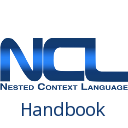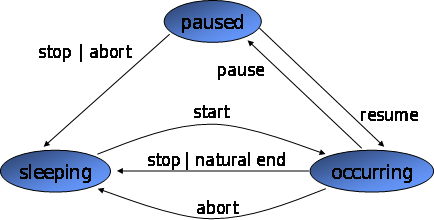The <causalConnector> Element
Definition and Usage
The <causalConnector> element represents a causal relation that may be used for creating relationships (<link> elements) in NCL documents. In a causal relation, a condition must be satisfied in order to trigger an action.
A <causalConnector> specifies a relation independently of relationships, that is, it does not specify which nodes (represented by <media>, <context>, <body>, and <switch> elements) will interact through the relation. A <link> element, in its turn, represents a relationship of the type defined by its referred connector, interconnecting different nodes. Links representing the same type of relation, but interconnecting different nodes, may reuse the same connector, reusing all its previous specification.
A <causalConnector> defines, through its child elements, a set of interface points, called roles. A <link> element refers to a <causalConnector> and defines a set of binds (<bind> child elements of the <link> element), which associate each link endpoint (node interface) to a role of the referred connector.
Relations in NCL are based on events. An NCL event is an occurrence in time that may be instantaneous or have a measurable duration. Each event defines a state machine that is maintained by the NCL player (see Figure 1). Moreover, every event has an associated attribute, named occurrences, which counts how many times the event transits from occurring to sleeping state during a document presentation. Events of presentation and attribution types have also an attribute named repetitions, which counts how many times the event shall be automatically restarted (transited from sleeping to occurring states) by the NCL player. This attribute may contain the “indefinite” value, leading to an endless loop of the event occurrences until some external interruption.
NCL 3.0 EDTV profile defines the following types of events:
- presentation event: defined by the presentation of a subset of information units of a media object content. Presentation events are specified in NCL on <area> elements, or on media nodes themselves (on their whole content anchors). Presentation events may also be defined on composite nodes (represented by <body>, <context>, or <switch> elements), representing the presentation of information units of any node inside the composite node);
- selection event: defined by the selection of a subset of information units of a media object content being presented. Selection events are specified in NCL on <area> elements, or on media nodes themselves (on their whole content anchors);
- attribution event: defined by the attribution of a value to a property of a node (represented by a <media>, <body>, or <context> element), which must be declared in a <property> child element of the node; and
Syntax
| Element | Attributes | Content | Parent |
|---|---|---|---|
| <causalConnector> | id | (<connectorParam>*, (<simpleCondition> | <compoundCondition>), (<simpleAction> | <compoundAction>)) | <connectorBase> |
Attributes
| Name | Value | Description |
|---|---|---|
| id | It may receive any string value that begins with a letter or an underscore and that only contains letters, digits, “.”, and “_”. | The id attribute uniquely identifies the element within a document. |

